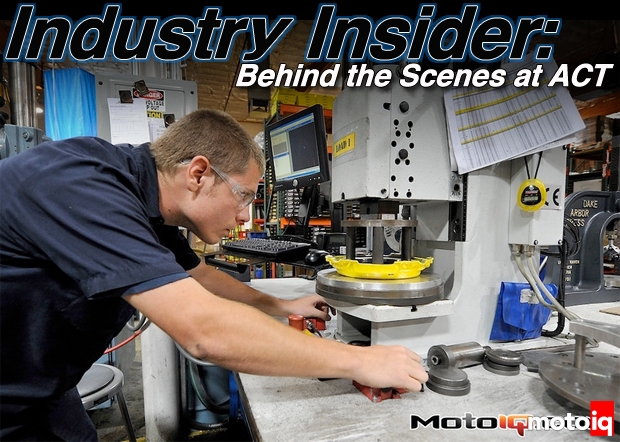,
 |
| Stacks of blank pressure rings await machining. ACT pressure rings are made of stronger ductile iron. |
The Quality department also performs receiving, in-process and final inspections to help ensure that only a good product goes out the door. Full traceability is maintained throughout the production process. If there is a problem, a defective clutch can be traced down to the batch number, the processes used and even which operators worked on building the clutch. This is a powerful tool to help track defects and make process and design improvements.
 |
| The blank pressure rings have their mounting holes, fulcrums and other features machined in this CNC machine. |
 |
| This is the fulcrum pivot for the diaphragm spring. On a blank ACT pressure ring, this area is cast extra wide and extra tall so it can be machined over a wide area. This gives ACT engineers a lot of control over pedal feel, engagement height and travel. |
One of the rumors about ACT and other clutch companies is that many HD clutches are simply resourced imported pressure plates with perhaps just simple changes in the diaphragm spring or perhaps just a quick coat of colored spray paint to “brand” a part. Well in the case of ACT this is simply not true.
 |
| ACT drive straps are much thicker and stronger with this angle bent into them for a more consistent release. Stock drive straps are just flat pieces of metal. Amazingly the engine’s torque is transfered through these little straps! |
The first stage of the manufacture of an ACT clutch is receiving. Here the raw materials to make an ACT clutch arrive, are inspected and inventoried. Generally ACT uses pressure rings and diaphragm springs of their own design. ACT pressure rings are made out of ductile iron, a superior grade of cast iron with higher heat resistance and a higher tensile strength. The diaphragm springs are redesigned for a higher clamping load and with careful thought to engagement height and release clearances.
 |
| Diaphragm springs await assembly into pressure plates. |
In high volume cases ACT uses their own design of pressure plate cover but for many clutches it is purchased from a supplier and sometimes even bought as a complete pressure plate assembly. In this case ACT disassembles the pressure plate so the cover can be used.
 |
| ACT Diaphragm springs are sometimes embossed with these ribs as seen on the spring on the left to increase clamp load by making the spring stiffer. |
ACT has an innovative production process. Much of ACT’s tooling is designed to work across a wide range of products. Much of the tooling is flexible so its configuration can be quickly changed. Many of ACT’s in-house designed components are also designed to be flexible and easily adaptable across a large variety of products. What this means is that ACT can make short runs of products with minimal variation and high quality. Flexible tooling and parts with the ability to efficiently make short production runs also means high quality and low price for the performance.
|

|
| ACT heat treats their diaphragm springs in house to improve quality control in this specially controlled high temperature oven. |
 |
| The components of a pressure plate: the cover, pressure ring, diaphragm spring, pivot rings, drive straps (already riveted in place in the cover) and rivets to hold it all together. |
 |
| Stacks of clutch covers await assembly. |
Related












